Strategic Information Systems Planning: 12 Week Learning Journal
VerifiedAdded on 2020/03/16
|8
|1942
|39
Journal and Reflective Writing
AI Summary
This assignment presents a 12-week learning journal focusing on Strategic Information Systems Planning (SISP) within the context of Business and Information Technology. The journal meticulously documents the student's learning journey, encompassing research paradigms, theoretical knowledge, and practical applications. Each week highlights specific aspects, such as the components of a good research proposal, the selection of research topics, literature reviews, ethical considerations, and the application of mature business decisions. The journal explores the composition of effective SISP teams, qualitative and quantitative research methods, questionnaire design, sampling techniques, focus groups, interview analysis, and data assimilation for decision-making. It emphasizes the importance of each step for building a successful and reliable business strategy. The study underscores the significance of thoroughness, ethical compliance, and data-driven decision-making in achieving relevant and successful outcomes in business planning.
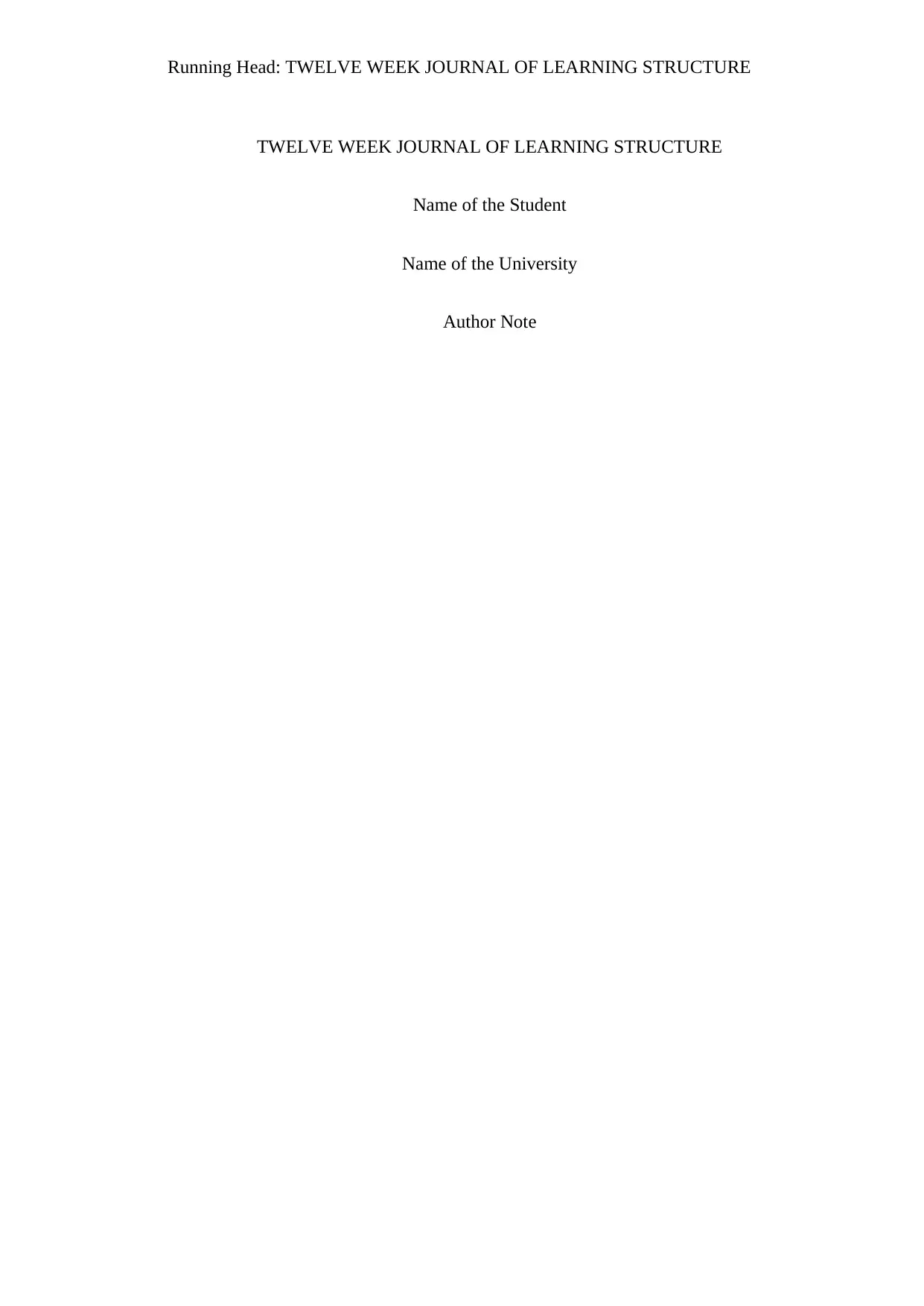
Running Head: TWELVE WEEK JOURNAL OF LEARNING STRUCTURE
TWELVE WEEK JOURNAL OF LEARNING STRUCTURE
Name of the Student
Name of the University
Author Note
TWELVE WEEK JOURNAL OF LEARNING STRUCTURE
Name of the Student
Name of the University
Author Note
Paraphrase This Document
Need a fresh take? Get an instant paraphrase of this document with our AI Paraphraser
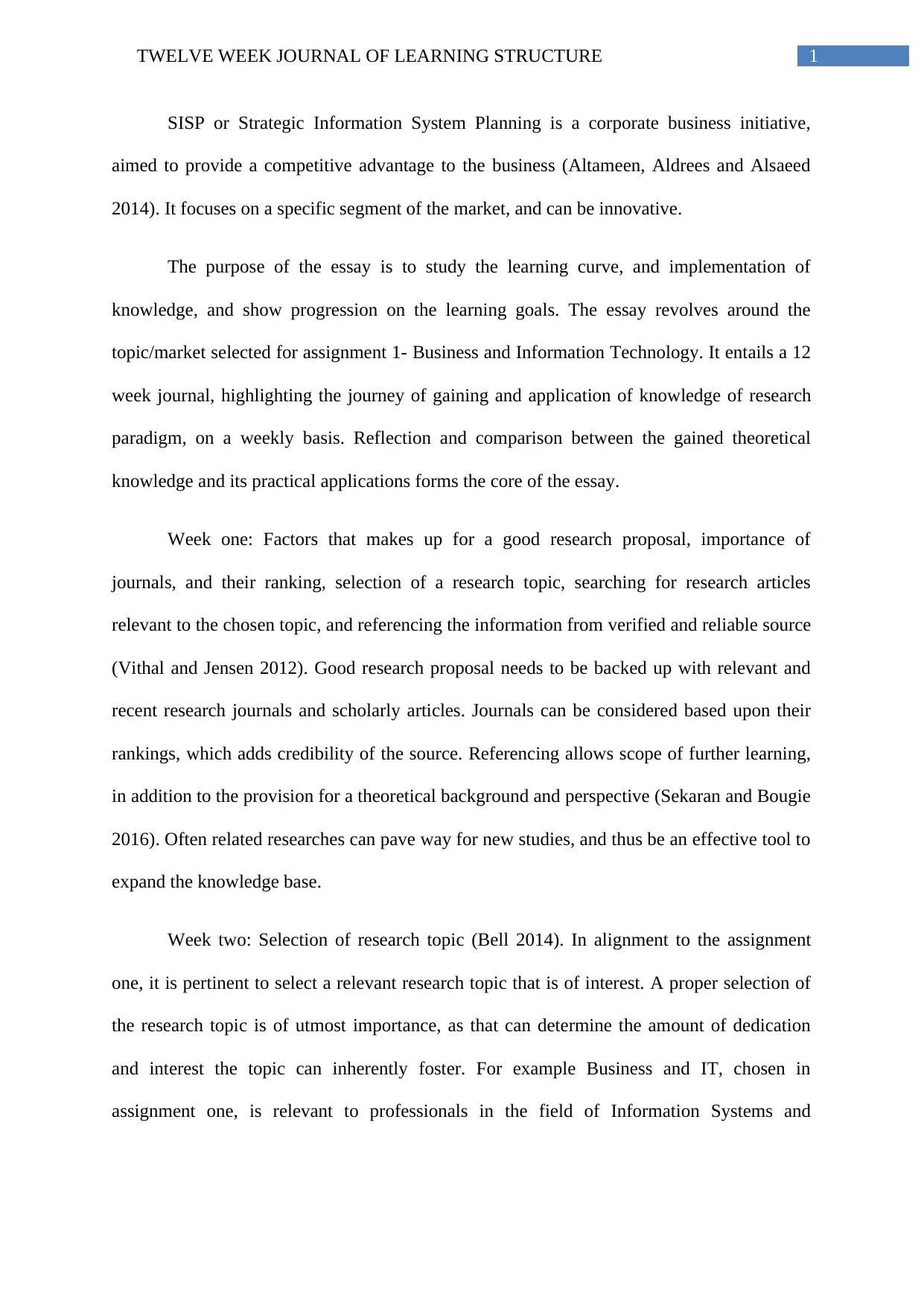
1TWELVE WEEK JOURNAL OF LEARNING STRUCTURE
SISP or Strategic Information System Planning is a corporate business initiative,
aimed to provide a competitive advantage to the business (Altameen, Aldrees and Alsaeed
2014). It focuses on a specific segment of the market, and can be innovative.
The purpose of the essay is to study the learning curve, and implementation of
knowledge, and show progression on the learning goals. The essay revolves around the
topic/market selected for assignment 1- Business and Information Technology. It entails a 12
week journal, highlighting the journey of gaining and application of knowledge of research
paradigm, on a weekly basis. Reflection and comparison between the gained theoretical
knowledge and its practical applications forms the core of the essay.
Week one: Factors that makes up for a good research proposal, importance of
journals, and their ranking, selection of a research topic, searching for research articles
relevant to the chosen topic, and referencing the information from verified and reliable source
(Vithal and Jensen 2012). Good research proposal needs to be backed up with relevant and
recent research journals and scholarly articles. Journals can be considered based upon their
rankings, which adds credibility of the source. Referencing allows scope of further learning,
in addition to the provision for a theoretical background and perspective (Sekaran and Bougie
2016). Often related researches can pave way for new studies, and thus be an effective tool to
expand the knowledge base.
Week two: Selection of research topic (Bell 2014). In alignment to the assignment
one, it is pertinent to select a relevant research topic that is of interest. A proper selection of
the research topic is of utmost importance, as that can determine the amount of dedication
and interest the topic can inherently foster. For example Business and IT, chosen in
assignment one, is relevant to professionals in the field of Information Systems and
SISP or Strategic Information System Planning is a corporate business initiative,
aimed to provide a competitive advantage to the business (Altameen, Aldrees and Alsaeed
2014). It focuses on a specific segment of the market, and can be innovative.
The purpose of the essay is to study the learning curve, and implementation of
knowledge, and show progression on the learning goals. The essay revolves around the
topic/market selected for assignment 1- Business and Information Technology. It entails a 12
week journal, highlighting the journey of gaining and application of knowledge of research
paradigm, on a weekly basis. Reflection and comparison between the gained theoretical
knowledge and its practical applications forms the core of the essay.
Week one: Factors that makes up for a good research proposal, importance of
journals, and their ranking, selection of a research topic, searching for research articles
relevant to the chosen topic, and referencing the information from verified and reliable source
(Vithal and Jensen 2012). Good research proposal needs to be backed up with relevant and
recent research journals and scholarly articles. Journals can be considered based upon their
rankings, which adds credibility of the source. Referencing allows scope of further learning,
in addition to the provision for a theoretical background and perspective (Sekaran and Bougie
2016). Often related researches can pave way for new studies, and thus be an effective tool to
expand the knowledge base.
Week two: Selection of research topic (Bell 2014). In alignment to the assignment
one, it is pertinent to select a relevant research topic that is of interest. A proper selection of
the research topic is of utmost importance, as that can determine the amount of dedication
and interest the topic can inherently foster. For example Business and IT, chosen in
assignment one, is relevant to professionals in the field of Information Systems and
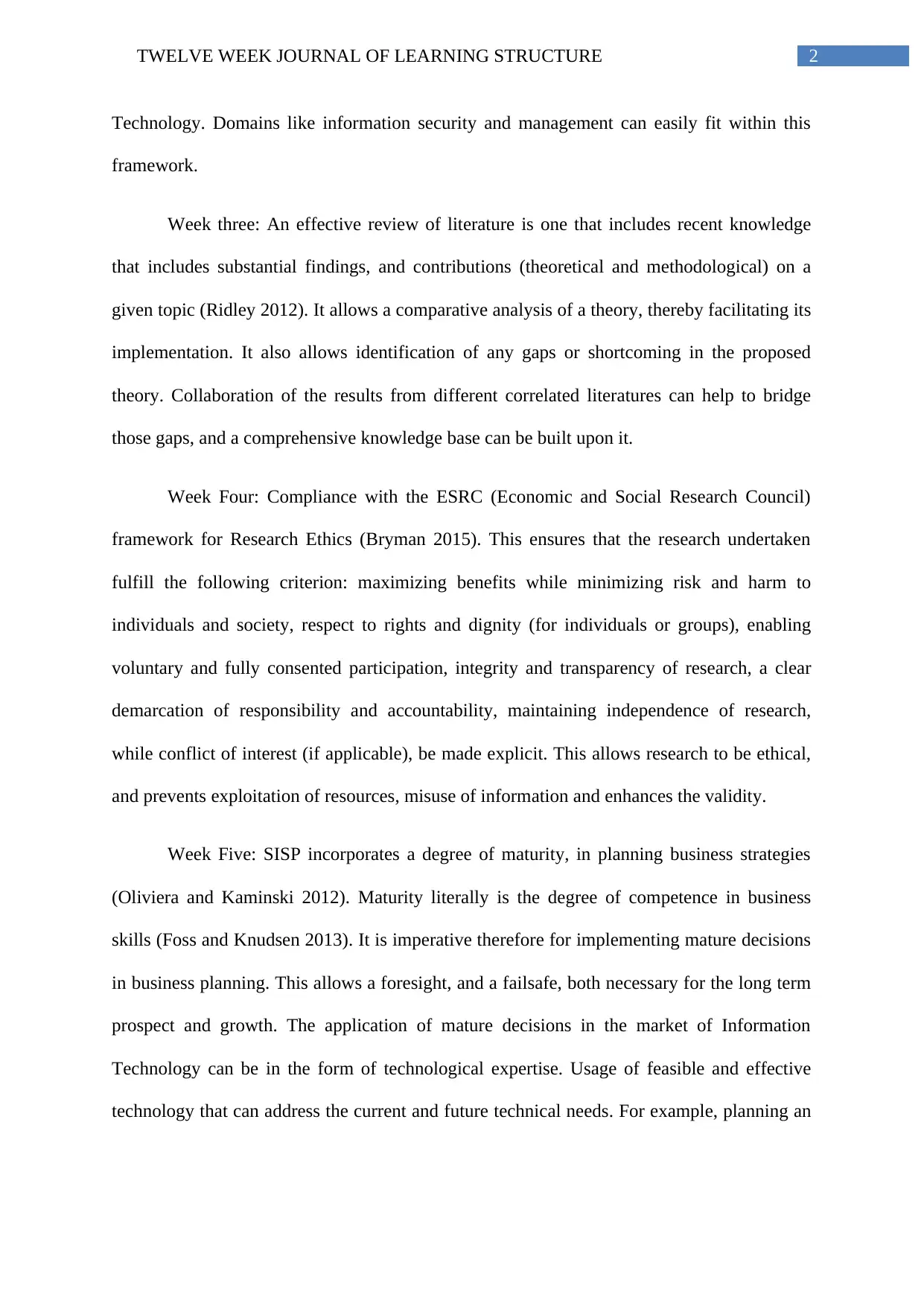
2TWELVE WEEK JOURNAL OF LEARNING STRUCTURE
Technology. Domains like information security and management can easily fit within this
framework.
Week three: An effective review of literature is one that includes recent knowledge
that includes substantial findings, and contributions (theoretical and methodological) on a
given topic (Ridley 2012). It allows a comparative analysis of a theory, thereby facilitating its
implementation. It also allows identification of any gaps or shortcoming in the proposed
theory. Collaboration of the results from different correlated literatures can help to bridge
those gaps, and a comprehensive knowledge base can be built upon it.
Week Four: Compliance with the ESRC (Economic and Social Research Council)
framework for Research Ethics (Bryman 2015). This ensures that the research undertaken
fulfill the following criterion: maximizing benefits while minimizing risk and harm to
individuals and society, respect to rights and dignity (for individuals or groups), enabling
voluntary and fully consented participation, integrity and transparency of research, a clear
demarcation of responsibility and accountability, maintaining independence of research,
while conflict of interest (if applicable), be made explicit. This allows research to be ethical,
and prevents exploitation of resources, misuse of information and enhances the validity.
Week Five: SISP incorporates a degree of maturity, in planning business strategies
(Oliviera and Kaminski 2012). Maturity literally is the degree of competence in business
skills (Foss and Knudsen 2013). It is imperative therefore for implementing mature decisions
in business planning. This allows a foresight, and a failsafe, both necessary for the long term
prospect and growth. The application of mature decisions in the market of Information
Technology can be in the form of technological expertise. Usage of feasible and effective
technology that can address the current and future technical needs. For example, planning an
Technology. Domains like information security and management can easily fit within this
framework.
Week three: An effective review of literature is one that includes recent knowledge
that includes substantial findings, and contributions (theoretical and methodological) on a
given topic (Ridley 2012). It allows a comparative analysis of a theory, thereby facilitating its
implementation. It also allows identification of any gaps or shortcoming in the proposed
theory. Collaboration of the results from different correlated literatures can help to bridge
those gaps, and a comprehensive knowledge base can be built upon it.
Week Four: Compliance with the ESRC (Economic and Social Research Council)
framework for Research Ethics (Bryman 2015). This ensures that the research undertaken
fulfill the following criterion: maximizing benefits while minimizing risk and harm to
individuals and society, respect to rights and dignity (for individuals or groups), enabling
voluntary and fully consented participation, integrity and transparency of research, a clear
demarcation of responsibility and accountability, maintaining independence of research,
while conflict of interest (if applicable), be made explicit. This allows research to be ethical,
and prevents exploitation of resources, misuse of information and enhances the validity.
Week Five: SISP incorporates a degree of maturity, in planning business strategies
(Oliviera and Kaminski 2012). Maturity literally is the degree of competence in business
skills (Foss and Knudsen 2013). It is imperative therefore for implementing mature decisions
in business planning. This allows a foresight, and a failsafe, both necessary for the long term
prospect and growth. The application of mature decisions in the market of Information
Technology can be in the form of technological expertise. Usage of feasible and effective
technology that can address the current and future technical needs. For example, planning an
⊘ This is a preview!⊘
Do you want full access?
Subscribe today to unlock all pages.

Trusted by 1+ million students worldwide
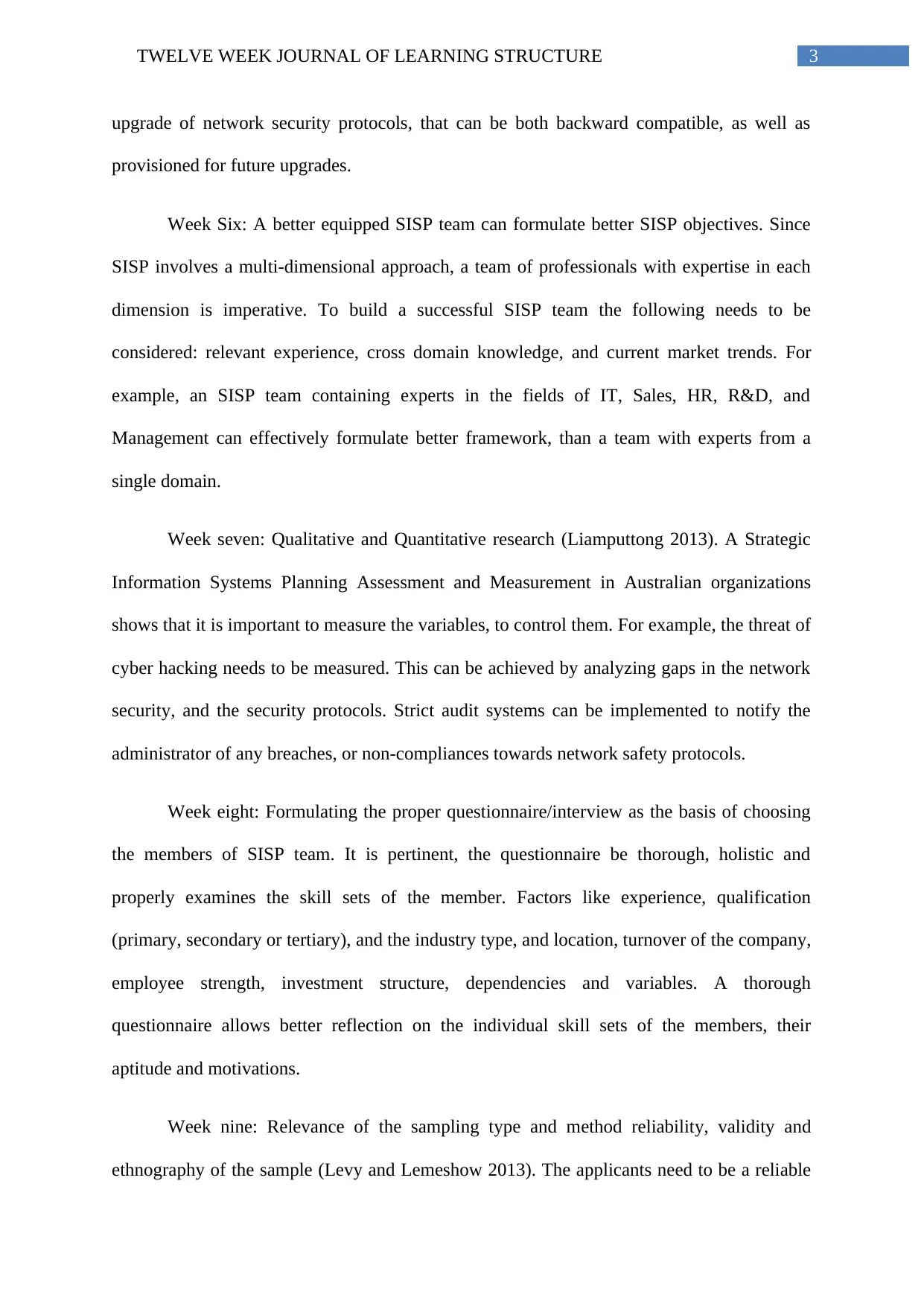
3TWELVE WEEK JOURNAL OF LEARNING STRUCTURE
upgrade of network security protocols, that can be both backward compatible, as well as
provisioned for future upgrades.
Week Six: A better equipped SISP team can formulate better SISP objectives. Since
SISP involves a multi-dimensional approach, a team of professionals with expertise in each
dimension is imperative. To build a successful SISP team the following needs to be
considered: relevant experience, cross domain knowledge, and current market trends. For
example, an SISP team containing experts in the fields of IT, Sales, HR, R&D, and
Management can effectively formulate better framework, than a team with experts from a
single domain.
Week seven: Qualitative and Quantitative research (Liamputtong 2013). A Strategic
Information Systems Planning Assessment and Measurement in Australian organizations
shows that it is important to measure the variables, to control them. For example, the threat of
cyber hacking needs to be measured. This can be achieved by analyzing gaps in the network
security, and the security protocols. Strict audit systems can be implemented to notify the
administrator of any breaches, or non-compliances towards network safety protocols.
Week eight: Formulating the proper questionnaire/interview as the basis of choosing
the members of SISP team. It is pertinent, the questionnaire be thorough, holistic and
properly examines the skill sets of the member. Factors like experience, qualification
(primary, secondary or tertiary), and the industry type, and location, turnover of the company,
employee strength, investment structure, dependencies and variables. A thorough
questionnaire allows better reflection on the individual skill sets of the members, their
aptitude and motivations.
Week nine: Relevance of the sampling type and method reliability, validity and
ethnography of the sample (Levy and Lemeshow 2013). The applicants need to be a reliable
upgrade of network security protocols, that can be both backward compatible, as well as
provisioned for future upgrades.
Week Six: A better equipped SISP team can formulate better SISP objectives. Since
SISP involves a multi-dimensional approach, a team of professionals with expertise in each
dimension is imperative. To build a successful SISP team the following needs to be
considered: relevant experience, cross domain knowledge, and current market trends. For
example, an SISP team containing experts in the fields of IT, Sales, HR, R&D, and
Management can effectively formulate better framework, than a team with experts from a
single domain.
Week seven: Qualitative and Quantitative research (Liamputtong 2013). A Strategic
Information Systems Planning Assessment and Measurement in Australian organizations
shows that it is important to measure the variables, to control them. For example, the threat of
cyber hacking needs to be measured. This can be achieved by analyzing gaps in the network
security, and the security protocols. Strict audit systems can be implemented to notify the
administrator of any breaches, or non-compliances towards network safety protocols.
Week eight: Formulating the proper questionnaire/interview as the basis of choosing
the members of SISP team. It is pertinent, the questionnaire be thorough, holistic and
properly examines the skill sets of the member. Factors like experience, qualification
(primary, secondary or tertiary), and the industry type, and location, turnover of the company,
employee strength, investment structure, dependencies and variables. A thorough
questionnaire allows better reflection on the individual skill sets of the members, their
aptitude and motivations.
Week nine: Relevance of the sampling type and method reliability, validity and
ethnography of the sample (Levy and Lemeshow 2013). The applicants need to be a reliable
Paraphrase This Document
Need a fresh take? Get an instant paraphrase of this document with our AI Paraphraser
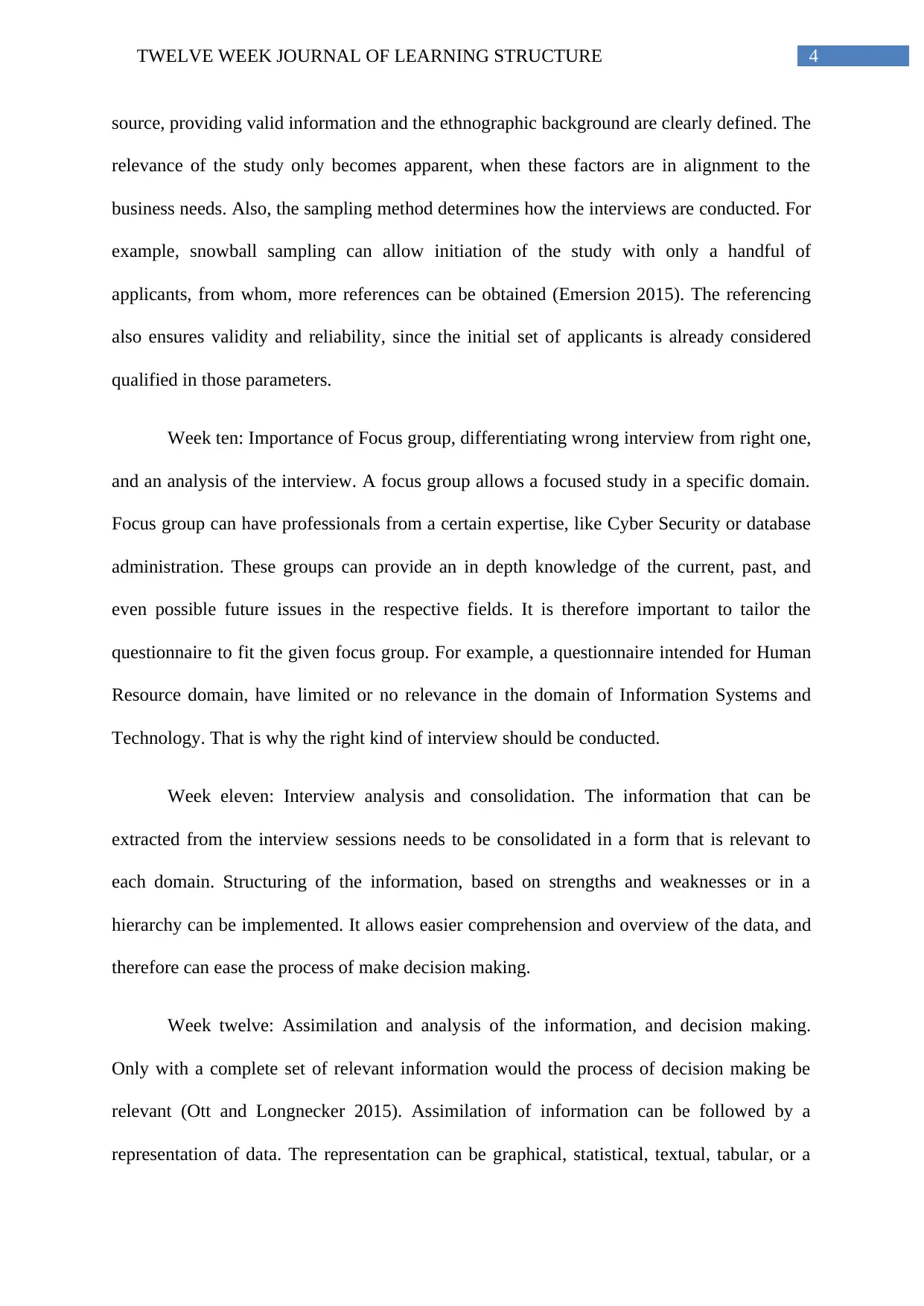
4TWELVE WEEK JOURNAL OF LEARNING STRUCTURE
source, providing valid information and the ethnographic background are clearly defined. The
relevance of the study only becomes apparent, when these factors are in alignment to the
business needs. Also, the sampling method determines how the interviews are conducted. For
example, snowball sampling can allow initiation of the study with only a handful of
applicants, from whom, more references can be obtained (Emersion 2015). The referencing
also ensures validity and reliability, since the initial set of applicants is already considered
qualified in those parameters.
Week ten: Importance of Focus group, differentiating wrong interview from right one,
and an analysis of the interview. A focus group allows a focused study in a specific domain.
Focus group can have professionals from a certain expertise, like Cyber Security or database
administration. These groups can provide an in depth knowledge of the current, past, and
even possible future issues in the respective fields. It is therefore important to tailor the
questionnaire to fit the given focus group. For example, a questionnaire intended for Human
Resource domain, have limited or no relevance in the domain of Information Systems and
Technology. That is why the right kind of interview should be conducted.
Week eleven: Interview analysis and consolidation. The information that can be
extracted from the interview sessions needs to be consolidated in a form that is relevant to
each domain. Structuring of the information, based on strengths and weaknesses or in a
hierarchy can be implemented. It allows easier comprehension and overview of the data, and
therefore can ease the process of make decision making.
Week twelve: Assimilation and analysis of the information, and decision making.
Only with a complete set of relevant information would the process of decision making be
relevant (Ott and Longnecker 2015). Assimilation of information can be followed by a
representation of data. The representation can be graphical, statistical, textual, tabular, or a
source, providing valid information and the ethnographic background are clearly defined. The
relevance of the study only becomes apparent, when these factors are in alignment to the
business needs. Also, the sampling method determines how the interviews are conducted. For
example, snowball sampling can allow initiation of the study with only a handful of
applicants, from whom, more references can be obtained (Emersion 2015). The referencing
also ensures validity and reliability, since the initial set of applicants is already considered
qualified in those parameters.
Week ten: Importance of Focus group, differentiating wrong interview from right one,
and an analysis of the interview. A focus group allows a focused study in a specific domain.
Focus group can have professionals from a certain expertise, like Cyber Security or database
administration. These groups can provide an in depth knowledge of the current, past, and
even possible future issues in the respective fields. It is therefore important to tailor the
questionnaire to fit the given focus group. For example, a questionnaire intended for Human
Resource domain, have limited or no relevance in the domain of Information Systems and
Technology. That is why the right kind of interview should be conducted.
Week eleven: Interview analysis and consolidation. The information that can be
extracted from the interview sessions needs to be consolidated in a form that is relevant to
each domain. Structuring of the information, based on strengths and weaknesses or in a
hierarchy can be implemented. It allows easier comprehension and overview of the data, and
therefore can ease the process of make decision making.
Week twelve: Assimilation and analysis of the information, and decision making.
Only with a complete set of relevant information would the process of decision making be
relevant (Ott and Longnecker 2015). Assimilation of information can be followed by a
representation of data. The representation can be graphical, statistical, textual, tabular, or a
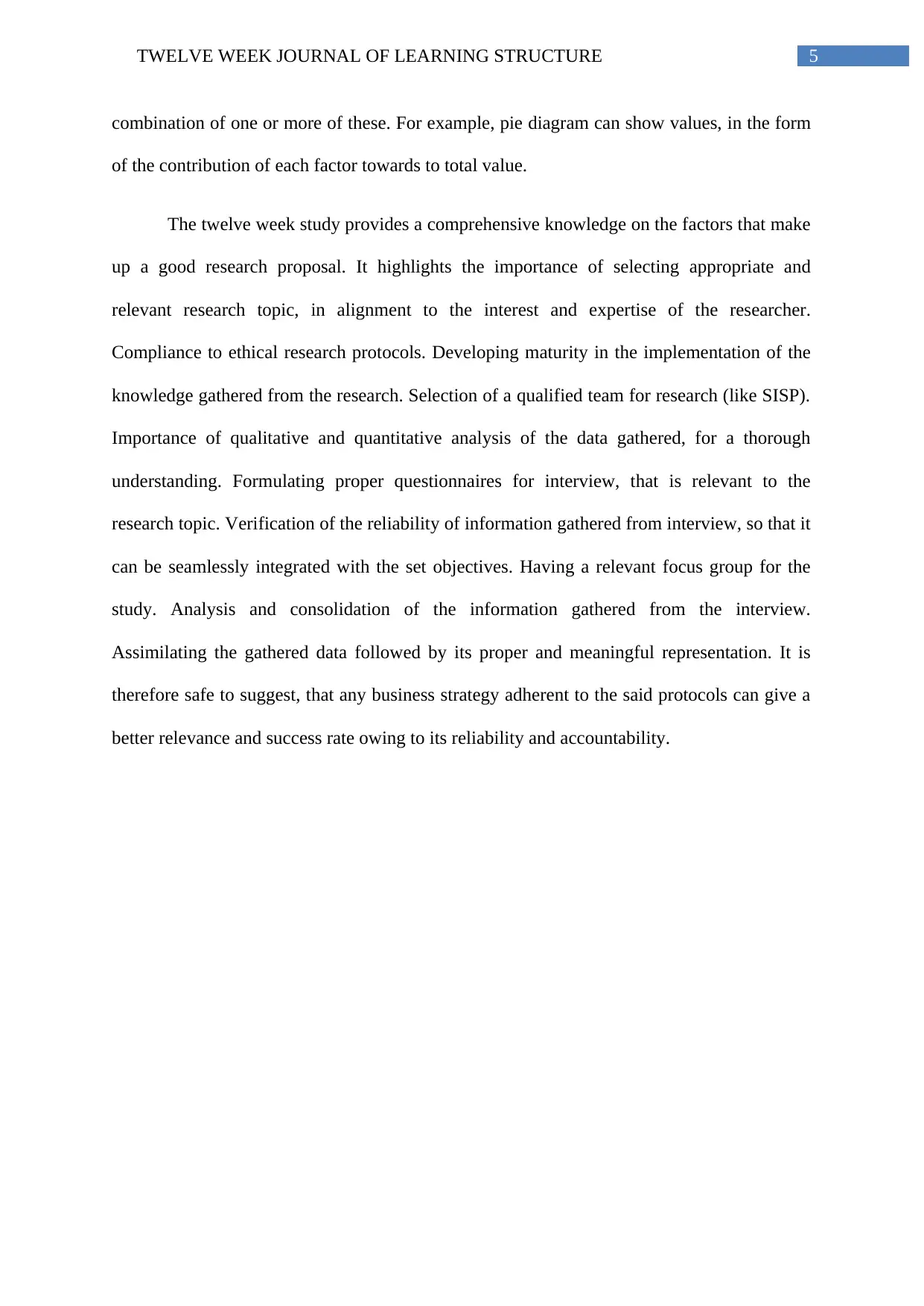
5TWELVE WEEK JOURNAL OF LEARNING STRUCTURE
combination of one or more of these. For example, pie diagram can show values, in the form
of the contribution of each factor towards to total value.
The twelve week study provides a comprehensive knowledge on the factors that make
up a good research proposal. It highlights the importance of selecting appropriate and
relevant research topic, in alignment to the interest and expertise of the researcher.
Compliance to ethical research protocols. Developing maturity in the implementation of the
knowledge gathered from the research. Selection of a qualified team for research (like SISP).
Importance of qualitative and quantitative analysis of the data gathered, for a thorough
understanding. Formulating proper questionnaires for interview, that is relevant to the
research topic. Verification of the reliability of information gathered from interview, so that it
can be seamlessly integrated with the set objectives. Having a relevant focus group for the
study. Analysis and consolidation of the information gathered from the interview.
Assimilating the gathered data followed by its proper and meaningful representation. It is
therefore safe to suggest, that any business strategy adherent to the said protocols can give a
better relevance and success rate owing to its reliability and accountability.
combination of one or more of these. For example, pie diagram can show values, in the form
of the contribution of each factor towards to total value.
The twelve week study provides a comprehensive knowledge on the factors that make
up a good research proposal. It highlights the importance of selecting appropriate and
relevant research topic, in alignment to the interest and expertise of the researcher.
Compliance to ethical research protocols. Developing maturity in the implementation of the
knowledge gathered from the research. Selection of a qualified team for research (like SISP).
Importance of qualitative and quantitative analysis of the data gathered, for a thorough
understanding. Formulating proper questionnaires for interview, that is relevant to the
research topic. Verification of the reliability of information gathered from interview, so that it
can be seamlessly integrated with the set objectives. Having a relevant focus group for the
study. Analysis and consolidation of the information gathered from the interview.
Assimilating the gathered data followed by its proper and meaningful representation. It is
therefore safe to suggest, that any business strategy adherent to the said protocols can give a
better relevance and success rate owing to its reliability and accountability.
⊘ This is a preview!⊘
Do you want full access?
Subscribe today to unlock all pages.

Trusted by 1+ million students worldwide
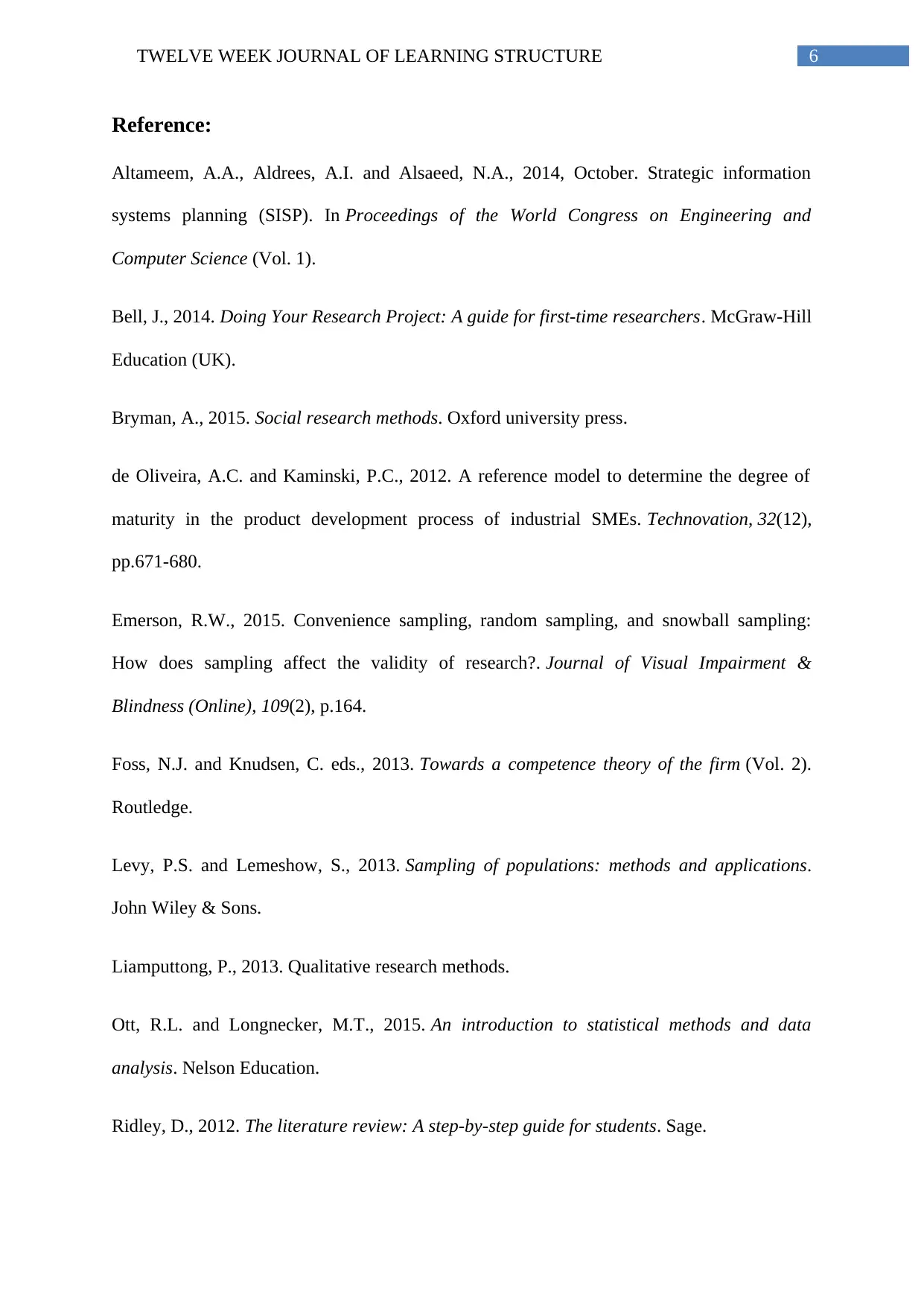
6TWELVE WEEK JOURNAL OF LEARNING STRUCTURE
Reference:
Altameem, A.A., Aldrees, A.I. and Alsaeed, N.A., 2014, October. Strategic information
systems planning (SISP). In Proceedings of the World Congress on Engineering and
Computer Science (Vol. 1).
Bell, J., 2014. Doing Your Research Project: A guide for first-time researchers. McGraw-Hill
Education (UK).
Bryman, A., 2015. Social research methods. Oxford university press.
de Oliveira, A.C. and Kaminski, P.C., 2012. A reference model to determine the degree of
maturity in the product development process of industrial SMEs. Technovation, 32(12),
pp.671-680.
Emerson, R.W., 2015. Convenience sampling, random sampling, and snowball sampling:
How does sampling affect the validity of research?. Journal of Visual Impairment &
Blindness (Online), 109(2), p.164.
Foss, N.J. and Knudsen, C. eds., 2013. Towards a competence theory of the firm (Vol. 2).
Routledge.
Levy, P.S. and Lemeshow, S., 2013. Sampling of populations: methods and applications.
John Wiley & Sons.
Liamputtong, P., 2013. Qualitative research methods.
Ott, R.L. and Longnecker, M.T., 2015. An introduction to statistical methods and data
analysis. Nelson Education.
Ridley, D., 2012. The literature review: A step-by-step guide for students. Sage.
Reference:
Altameem, A.A., Aldrees, A.I. and Alsaeed, N.A., 2014, October. Strategic information
systems planning (SISP). In Proceedings of the World Congress on Engineering and
Computer Science (Vol. 1).
Bell, J., 2014. Doing Your Research Project: A guide for first-time researchers. McGraw-Hill
Education (UK).
Bryman, A., 2015. Social research methods. Oxford university press.
de Oliveira, A.C. and Kaminski, P.C., 2012. A reference model to determine the degree of
maturity in the product development process of industrial SMEs. Technovation, 32(12),
pp.671-680.
Emerson, R.W., 2015. Convenience sampling, random sampling, and snowball sampling:
How does sampling affect the validity of research?. Journal of Visual Impairment &
Blindness (Online), 109(2), p.164.
Foss, N.J. and Knudsen, C. eds., 2013. Towards a competence theory of the firm (Vol. 2).
Routledge.
Levy, P.S. and Lemeshow, S., 2013. Sampling of populations: methods and applications.
John Wiley & Sons.
Liamputtong, P., 2013. Qualitative research methods.
Ott, R.L. and Longnecker, M.T., 2015. An introduction to statistical methods and data
analysis. Nelson Education.
Ridley, D., 2012. The literature review: A step-by-step guide for students. Sage.
Paraphrase This Document
Need a fresh take? Get an instant paraphrase of this document with our AI Paraphraser
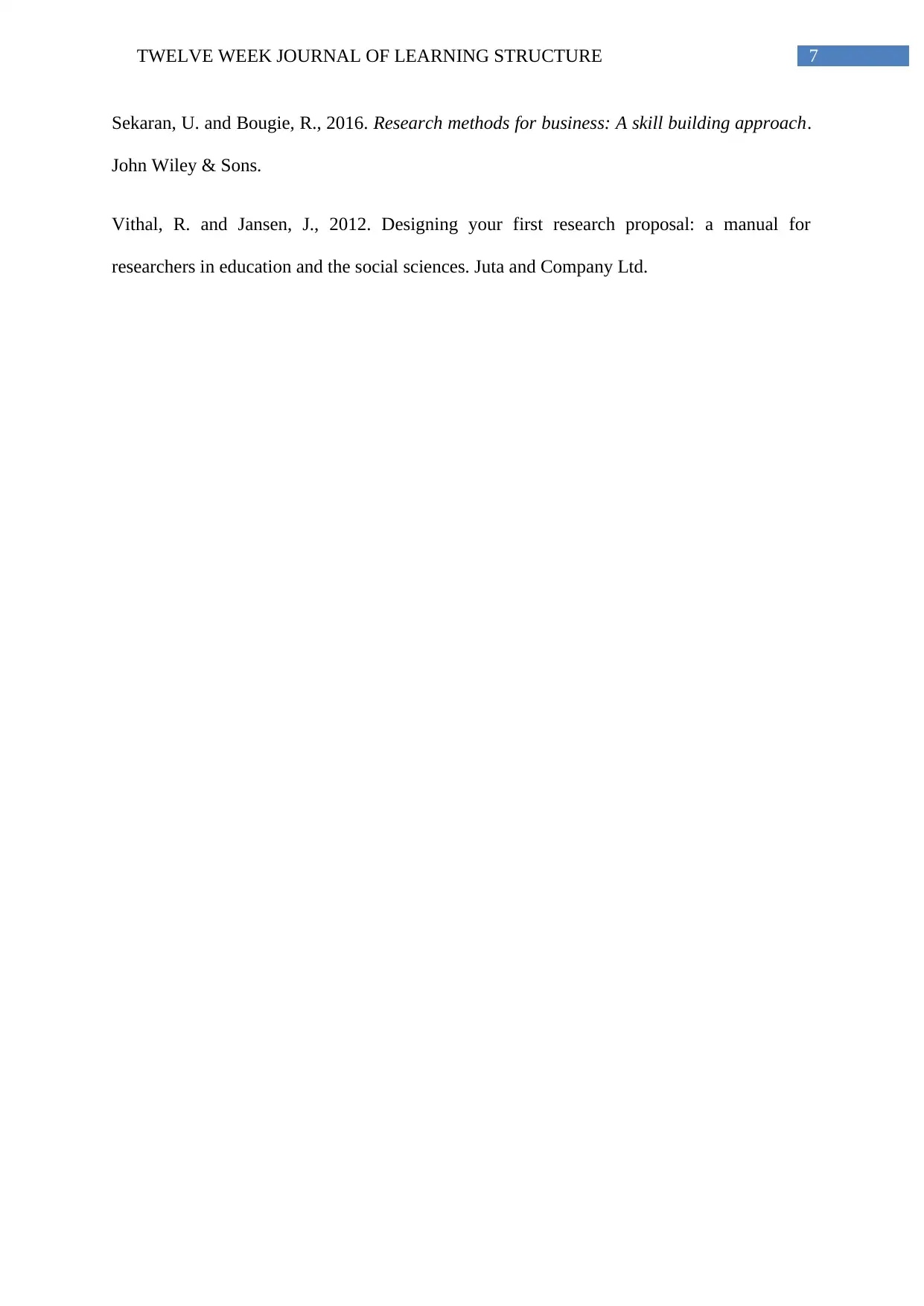
7TWELVE WEEK JOURNAL OF LEARNING STRUCTURE
Sekaran, U. and Bougie, R., 2016. Research methods for business: A skill building approach.
John Wiley & Sons.
Vithal, R. and Jansen, J., 2012. Designing your first research proposal: a manual for
researchers in education and the social sciences. Juta and Company Ltd.
Sekaran, U. and Bougie, R., 2016. Research methods for business: A skill building approach.
John Wiley & Sons.
Vithal, R. and Jansen, J., 2012. Designing your first research proposal: a manual for
researchers in education and the social sciences. Juta and Company Ltd.
1 out of 8
Related Documents
Your All-in-One AI-Powered Toolkit for Academic Success.
+13062052269
info@desklib.com
Available 24*7 on WhatsApp / Email
![[object Object]](/_next/static/media/star-bottom.7253800d.svg)
Unlock your academic potential
Copyright © 2020–2025 A2Z Services. All Rights Reserved. Developed and managed by ZUCOL.





